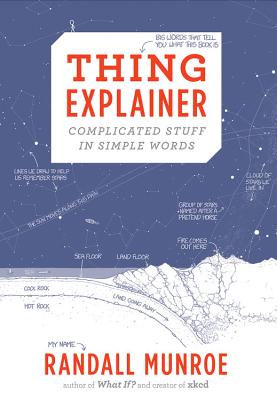Holiday gift book recommendation #1: Thing Explainer
(Every Wednesday in December before Christmas, we’ll talk to a Seattle bookseller about the gift book they’re most excited about this season.)
Alex Gholz, bookseller at Third Place Books Ravenna, has eclectic tastes. His recent reading of James S.A. Corey’s Leviathan Wakes put him on a brief space opera kick — he’s right now reading Alatair Reynold’s Revelation Space, and after that he’s planning to dive into Seth Dickinson’s political fantasy novel The Traitor Baru Cormorant. But just when you think you’ve got Gholz’s reading tastes figured out, he casually mentions that he just finished his first Oliver Sacks book, Seeing Voices, and then he can’t say enough good things about Lev Golinkin’s memoir A Backpack, a Bear, and Eight Crates of Vodka, which he encountered as part of “an Eastern European history binge.”
So what kind of a gift book does a sci-fi lover who adored both Oliver Sacks’s history of ASL and a hilarious account of early-90s eastern European immigration recommend to shoppers looking for the perfect gift book? Gholz is a passionate advocate for XKCD cartoonist Randall Munroe’s new book Thing Explainer: Complicated Stuff in Simple Words.

Gholz says he “grew up on David Macaulay’s The Way Things Work. I spent days and weeks and months looking at that book, well into adulthood.” Thing Explainer, he says, is like “a new edition of Macauley’s book, in some ways.”
So who is Thing Explainer for? “It’s a book that both parents and children can enjoy together and individually. You’ll spend hours going over” the illustrations, Gholz promises, which are “drawn almost like blueprints.” He continues, “I think this book would be perfect for basically any parent who has a child between maybe ages 7 to twelve and wants to share an experience of iguring out what’s going on with science today.” He can say from experience it's a book that even an intellectually voracious reader will return to again and again.